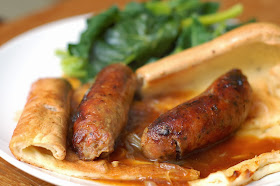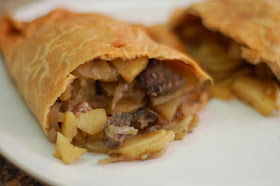This recipe is not some sort of 'family secret' passed down from my Babcia. Instead I've put together some of my favourite Polish flavours using the ingredients I can find here in Bangkok to create an 'inspired by' dish. You don't have to use homemade kluski, gnocchi would work well here or any other kind of pasta for the matter but when it's comfort food I'm after it has to be kluski.
Ingredients Serves 2-3 as a main course
1 quantity of kluski dough, pre-cooked in any shape you choose.
1 can (411g) sauerkraut (rinse in water if you want a less sour taste)180g brown mushrooms, finely sliced (small tray)
handful fresh dill, chopped
2 medium onions (about 1 1/2 cups), peeled and finely diced
1 tbsp vegetable oil
1 tbsp butter
2 cloves garlic, crushed
1 tsp smoked paprika (sweet or hot - your choice)
200ml water
MEATBALLS:
180g minced pork, beef or a mixture
2 tbsp browned onions (see below)
1/2 tsp ground allspice
salt
pepper
NOTES: This dish is great with boiled kluski but if you want a different texture you can fry the kluski after they've been boiled.
- Start by sauteing the onion in the oil and butter over a medium low heat until it is all golden brown with a natural sweetness. This will take about 10-20 minutes or so.
- Once the onions are browned, put about 2 tbsps in a bowl ready to mixed with the meatball mixture.
- Return the pan to a medium heat (still using the same oil, butter mixture and you cooked the meat and onions in) and saute the mushrooms with the onions until they have softened a little.
- Stir through the sauerkraut and add the water, smoked paprika and some ground black pepper then cook over a low to medium heat for 20 minutes or so. Keep an eye on the moisture level and add extra water as you desire.
- While the kapusta is bubbling away it's time to make the meatballs. Combine all the meatball ingredients together until evenly mixed. Next, heat up a frying pan with a little oil and form small meatballs using around a teaspoon of mixture each time then fry until browned on all sides and cooked through.
- Once the kapusta is at your desired consistency add in the pre-cooked kluski and meatballs. Taste and adjust seasoning as you wish. Then cook everything together for a further 5 minutes or so.
- Just before serving stir through the chopped fresh dill and serve with a dollop of soured cream if you wish.











































